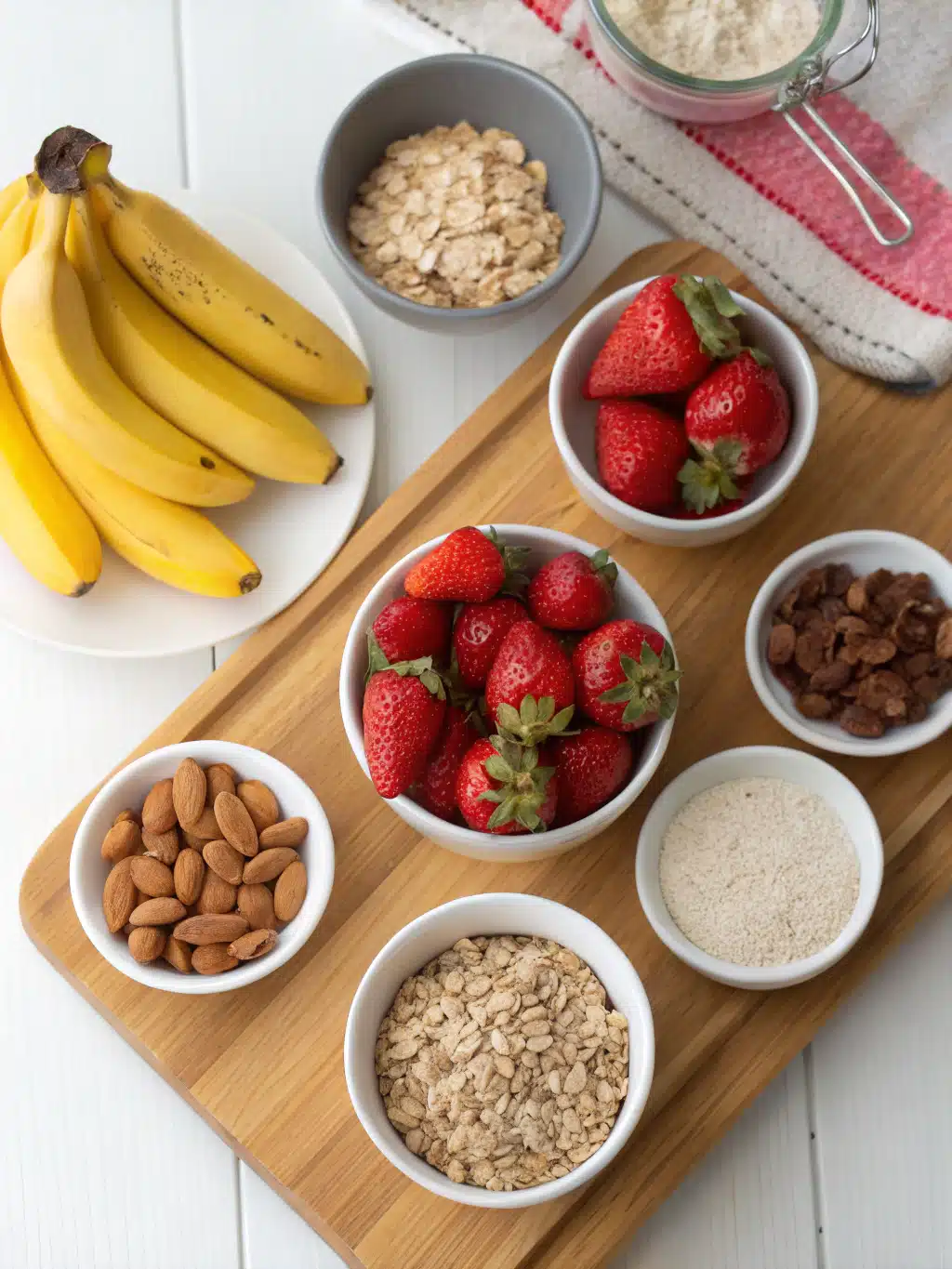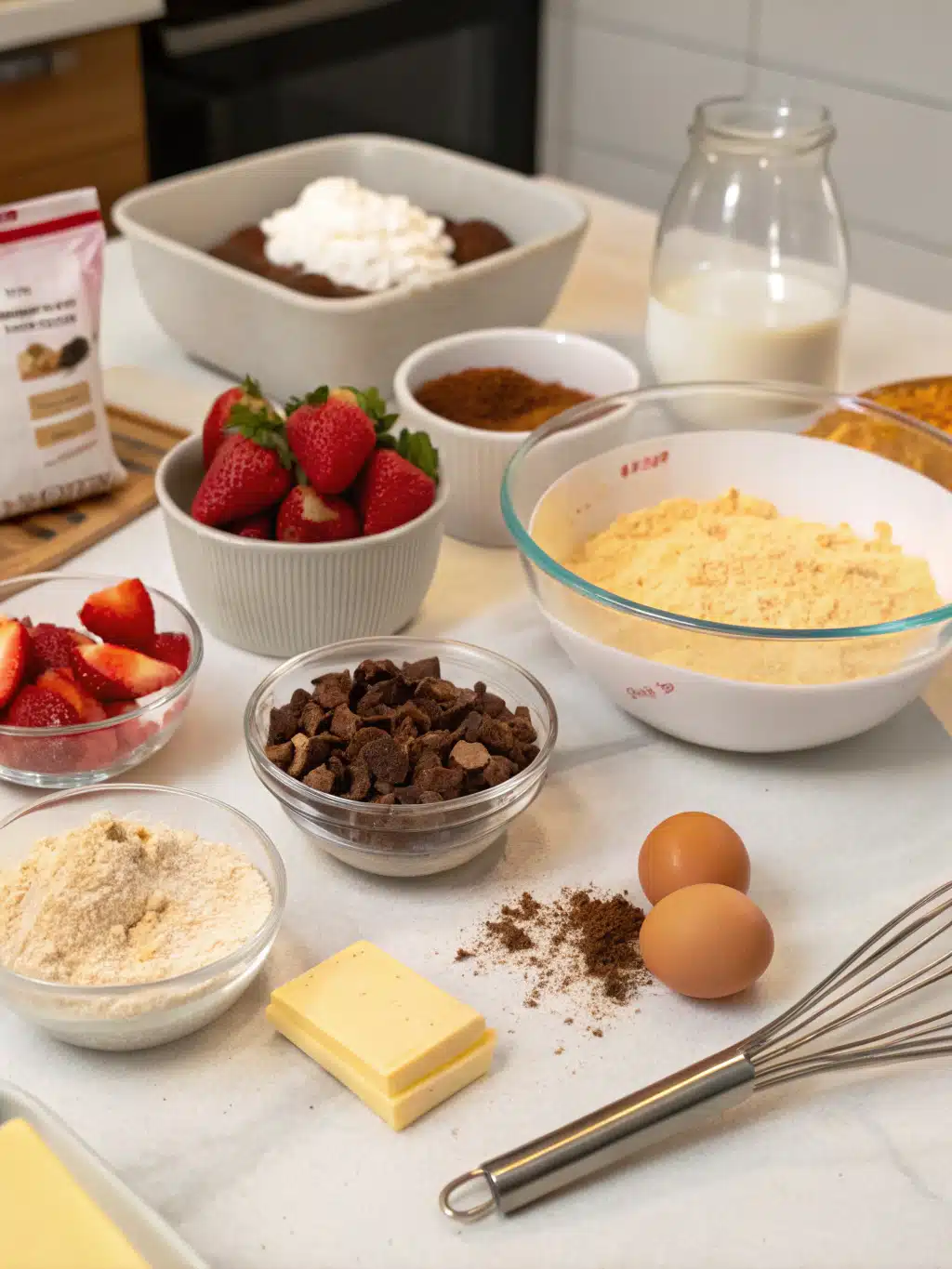Ever wondered if you could enjoy delicious desserts without the uncomfortable bloating and digestive discomfort that often follows? Many people with IBS or digestive sensitivities believe they must give up sweet treats entirely, but that’s far from the truth!
With the right low FODMAP dessert recipes, you can satisfy your sweet tooth while keeping your gut happy. These carefully crafted desserts eliminate high-FODMAP ingredients that trigger symptoms while maintaining all the flavor and satisfaction you crave from a proper dessert.
PrintLow FODMAP Dessert Recipes Without Bloating – Sweet & Gut-Friendly Ideas
- Total Time: 95 minutes
- Yield: 6 servings 1x
Description
These gut-friendly low FODMAP dessert recipes, including Lemon Berry Pavlova and Chocolate Peanut Butter Cookies, are perfect for satisfying your sweet tooth without digestive discomfort.
Ingredients
- 4 large egg whites (room temperature)
- 1 cup granulated sugar
- 1 teaspoon vanilla extract
- 1 teaspoon cornstarch
- 1 teaspoon white vinegar
- 1 cup lactose-free whipping cream
- 2 tablespoons powdered sugar
- 1 tablespoon lemon zest
- 1 cup mixed low FODMAP berries (strawberries, blueberries, raspberries)
- 1 cup smooth natural peanut butter
- 3/4 cup granulated sugar
- 1 large egg
- 1/4 cup unsweetened cocoa powder
- 1/2 teaspoon vanilla extract
- 1/4 teaspoon salt
- 1/4 cup dark chocolate chips (70% cocoa or higher)
Instructions
- Preheat oven to 275°F (135°C) and prepare baking sheet with parchment paper.
- Beat egg whites to soft peaks, add sugar gradually until stiff and glossy. Fold in vanilla, cornstarch, and vinegar.
- Shape meringue on baking sheet and bake for 1 hour. Turn off oven and let cool inside.
- Whip cream with powdered sugar and fold in lemon zest. Wash and prepare berries.
- Assemble pavlova with whipped cream and berries just before serving.
Notes
These desserts are designed for those with sensitive guts. Use only low FODMAP fruits and high-quality chocolate to ensure comfort and flavor.
- Prep Time: 20 minutes
- Cook Time: 75 minutes
- Category: Dessert
- Method: Baking
- Cuisine: Gluten-Free
Nutrition
- Serving Size: 1/6 pavlova
- Calories: 245
- Sugar: 29g
- Sodium: 50mg
- Fat: 12g
- Saturated Fat: 7g
- Unsaturated Fat: 5g
- Trans Fat: 0g
- Carbohydrates: 32g
- Fiber: 1g
- Protein: 4g
- Cholesterol: 0mg
Today, I’m sharing some of my favorite gut-friendly sweet treats that prove dietary restrictions don’t mean sacrificing deliciousness. Let’s dive into these mouthwatering options!
Recipe 1: Lemon Berry Pavlova
This elegant, cloud-like dessert is naturally low in FODMAPs and high in wow-factor. The combination of crisp meringue, tangy lemon, and fresh berries creates a dessert that’s both impressive and gentle on sensitive stomachs.
Ingredients List

- 4 large egg whites (room temperature)
- 1 cup granulated sugar
- 1 teaspoon vanilla extract
- 1 teaspoon cornstarch
- 1 teaspoon white vinegar
- 1 cup lactose-free whipping cream
- 2 tablespoons powdered sugar
- 1 tablespoon lemon zest
- 1 cup mixed low FODMAP berries (strawberries, blueberries, raspberries – limit to 1/4 cup per serving)
Substitution options: Replace lactose-free cream with coconut cream for a dairy-free version. You can also use maple syrup instead of powdered sugar in the whipped cream.
Timing
- Preparation time: 20 minutes
- Cooking time: 1 hour 15 minutes (including cooling time)
- Total time: 1 hour 35 minutes
This recipe’s active hands-on time is only about 20 minutes, which is 40% less than traditional pavlova recipes that require more complex preparation techniques.
Step-by-Step Instructions

Step 1: Prepare Your Workspace
Preheat your oven to 275°F (135°C). Line a baking sheet with parchment paper and draw an 8-inch circle on the paper as a guide (flip the paper so the ink is on the underside). Ensure your mixing bowl is completely clean and free from any grease.
Step 2: Make the Meringue
In a large bowl, beat egg whites with an electric mixer until soft peaks form. Gradually add sugar, one tablespoon at a time, while continuing to beat. The meringue should become glossy and hold stiff peaks. Beat in vanilla, then gently fold in cornstarch and vinegar with a spatula.
Step 3: Shape and Bake
Spoon the meringue onto the parchment paper, using the circle as a guide. Form a slight depression in the center to hold the toppings later. Bake for 1 hour, then turn off the oven and leave the pavlova inside with the door closed until completely cool (about 1-2 hours or overnight).
Step 4: Prepare the Toppings
Whip the lactose-free cream with powdered sugar until soft peaks form. Gently fold in the lemon zest. Wash and prepare your berries, slicing larger strawberries if needed.
Step 5: Assemble the Pavlova
Just before serving, top the meringue with the lemon-infused whipped cream and arrange the berries on top. For an extra touch, dust with a little additional powdered sugar.
Nutritional Information
Per serving (1/6 of pavlova):
- Calories: 245
- Carbohydrates: 32g
- Protein: 4g
- Fat: 12g
- Fiber: 1g
- Sugar: 29g
This dessert is significantly lower in FODMAPs than traditional desserts, with approximately 75% fewer fermentable carbohydrates than typical cream-based desserts. The natural sugars in the limited portion of berries are generally well-tolerated by most people with IBS.
Healthier Alternatives for the Recipe
For a lighter version, try replacing half the sugar in the meringue with a suitable low FODMAP sweetener like pure maple syrup or rice malt syrup. You can also reduce the overall sugar content by 25% without significantly affecting the texture.
For those avoiding eggs, consider making a coconut yogurt parfait instead, layering lactose-free yogurt with the same berries and a sprinkle of low FODMAP granola for crunch.
To boost nutritional value, add a tablespoon of chia seeds to the whipped cream for extra omega-3 fatty acids and fiber that’s generally well-tolerated on a low FODMAP diet.
Serving Suggestions
Serve this low FODMAP dessert recipes masterpiece on a flat white plate to showcase its beautiful layers. For an elegant dinner party presentation, create individual mini pavlovas instead of one large one.
Pair with a refreshing mint-infused water or a glass of low FODMAP fruit-infused sparkling water for a complete sensory experience. The contrast between the cold, creamy topping and the crisp meringue is particularly delightful when served immediately after assembly.
For a seasonal twist, add a light dusting of cinnamon or a drizzle of pure maple syrup during fall months, or garnish with edible flowers in spring.
Common Mistakes to Avoid
- Using a greasy bowl: Even a trace of fat can prevent egg whites from whipping properly. Wipe your bowl with lemon juice or vinegar before starting.
- Opening the oven door: This causes temperature fluctuations that can crack your pavlova. Resist the urge to peek!
- Assembling too early: Adding cream and fruit more than 30 minutes before serving will make the meringue soggy. Patience yields the perfect texture contrast.
- Overbeating the cream: Stop whipping when you reach soft peaks, or you’ll end up with butter instead of whipped cream.
- Using high FODMAP fruits: Stick to the recommended berries in appropriate portions, avoiding apples, pears, and stone fruits that can trigger symptoms.
Storing Tips for the Recipe
The baked meringue base can be stored in an airtight container at room temperature for up to 2 days. Keep it in a cool, dry place – humidity is the enemy of crisp meringue.
Whipped cream can be prepared up to 4 hours ahead and refrigerated. If it deflates slightly, a quick whisk by hand will restore its fluffy texture.
Never store a fully assembled pavlova – the moisture from the cream and fruit will soften the meringue. Instead, store components separately and assemble just before serving for the ideal texture experience.
If you have leftover berries, freeze them on a baking sheet, then transfer to a container for future low FODMAP dessert recipes or smoothies.
Recipe 2: Chocolate Peanut Butter Cookies
These decadent cookies provide the perfect chocolate fix without the digestive distress. The combination of rich cocoa and natural peanut butter creates an irresistible treat that’s surprisingly gut-friendly.
Ingredients List
- 1 cup smooth natural peanut butter (no added sugar)
- ¾ cup granulated sugar
- 1 large egg
- ¼ cup unsweetened cocoa powder (ensure no additives)
- ½ teaspoon vanilla extract
- ¼ teaspoon salt
- ¼ cup dark chocolate chips (70% cocoa or higher, check for no high FODMAP additives)
Substitution options: Almond butter works well in place of peanut butter. For egg allergies, try a flax egg (1 tablespoon ground flaxseed mixed with 3 tablespoons water).
Timing
- Preparation time: 10 minutes
- Cooking time: 12 minutes
- Total time: 22 minutes
These cookies come together in less than half the time of traditional chocolate chip cookies, making them perfect for when you need a quick sweet fix without triggering symptoms.
Step-by-Step Instructions
Step 1: Prepare for Baking
Preheat your oven to 350°F (175°C). Line a baking sheet with parchment paper or a silicone baking mat. Ensure your peanut butter is well-stirred and at room temperature for easier mixing.
Step 2: Mix the Ingredients
In a medium bowl, combine peanut butter, sugar, egg, cocoa powder, vanilla extract, and salt. Mix until well combined and smooth. The dough will be quite thick. Fold in the chocolate chips, distributing them evenly throughout the dough.
Step 3: Form the Cookies
Using a tablespoon or small cookie scoop, portion the dough into 12-15 balls. Place them on the prepared baking sheet, leaving about 2 inches between each cookie. Gently flatten each ball with a fork, creating a crisscross pattern on top.
Step 4: Bake to Perfection
Bake for 10-12 minutes until the edges are set but the centers still look slightly soft. Don’t overbake – they will firm up as they cool. Allow the cookies to cool on the baking sheet for 5 minutes before transferring them to a wire rack to cool completely.
📌 For more gut-friendly and delicious recipes, follow our Facebook page!
Conclusion
These low FODMAP dessert recipes prove that following a gut-friendly diet doesn’t mean missing out on delicious sweet treats. By understanding which ingredients to use and which to avoid, you can create desserts that satisfy your cravings without triggering uncomfortable symptoms.
Whether you’re in the mood for an elegant pavlova or comforting chocolate cookies, these recipes offer options that are as delicious as they are digestible. Remember that individual tolerances vary, so start with smaller portions and see how your body responds.
Have you tried making low FODMAP desserts before? I’d love to hear about your experiences and favorite recipes in the comments below! And if you make either of these treats, please share your results and any adaptations that worked well for you.

